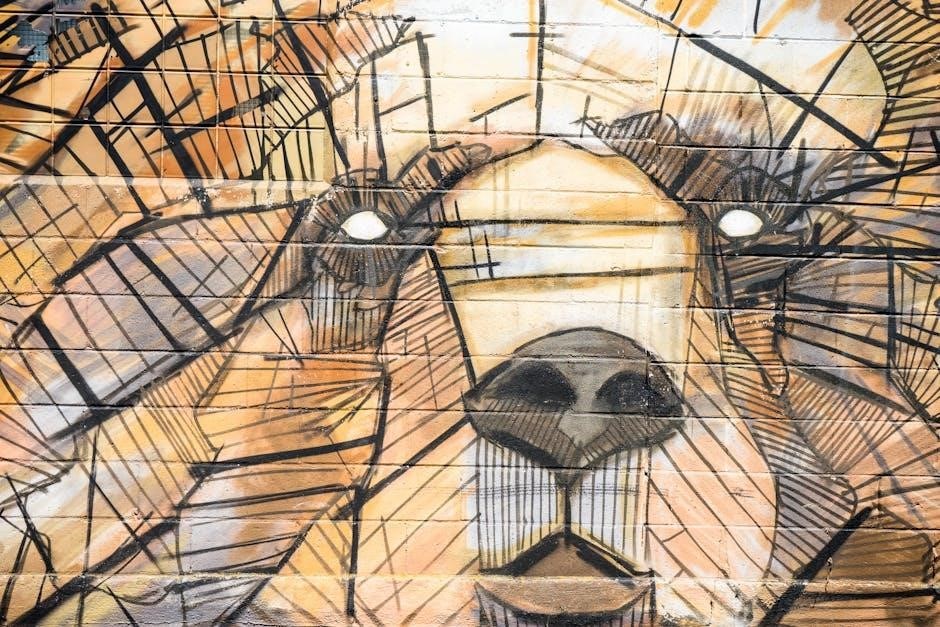This charming children’s book, authored by Bill Martin Jr. and illustrated by Eric Carle, introduces young readers to colorful animals and repetitive rhymes, making it a delightful early learning tool.
Overview of the Book
“Brown Bear, What Do You See?” is a charming children’s book that follows a brown bear as it encounters various animals, each contributing to the story’s rhythmic flow. The narrative is built around repetitive questioning, allowing young readers to predict outcomes and engage actively. The story introduces a cast of colorful animals, from red birds to yellow ducks, each making distinctive sounds that add to the sensory experience. With its simple yet engaging text, the book has become a beloved classic, combining storytelling with visual exploration. It is celebrated for its ability to captivate early learners while fostering a love for reading and discovery.
Significance of the “Brown Bear” Series
The “Brown Bear” series holds a special place in children’s literature due to its timeless appeal and educational value. It introduces young readers to essential skills like color recognition, animal identification, and rhythmic patterns. The series’ repetitive structure and engaging rhymes make it accessible and enjoyable for early learners. Its simplicity and predictability help build confidence in reading abilities. Over the years, the books have become staples in classrooms and homes, fostering a love for reading and learning. Their enduring popularity underscores their ability to connect with children and educators alike, making them a cornerstone of early childhood education and development.

Author and Illustrator Background
Bill Martin Jr. and Eric Carle collaborated on “Brown Bear,” blending rhythm and colorful collage illustrations. Their work has left a lasting legacy in children’s literature, sparking young imaginations globally.
Bill Martin Jr.: His Contribution to Children’s Literature
Bill Martin Jr. was a celebrated author known for his rhythmic and engaging storytelling in children’s literature. His collaboration with Eric Carle on Brown Bear, What Do You See? showcased his ability to create simple yet effective narratives for young readers. Martin’s writing style, characterized by repetition and predictability, made his books accessible and memorable for children. His work emphasized phonological awareness, language development, and a love for reading. As an educator-turned-author, Martin’s contributions have had a lasting impact on early childhood education, making his books timeless classics in classrooms and homes worldwide.
Eric Carle: The Renowned Illustrator
Eric Carle, a beloved illustrator, brought vibrant life to Brown Bear, What Do You See? through his signature collage technique. His colorful, hand-painted tissue paper cutouts captivated children and educators alike. Carle’s artwork not only complemented the story but also enhanced its educational value by visually representing animals and colors. His innovative style made complex concepts accessible to young learners. With a career spanning decades, Carle became a legend in children’s literature, creating timeless classics like The Very Hungry Caterpillar. His contributions to Brown Bear and other works have left a lasting legacy, inspiring creativity and curiosity in generations of readers.

Plot and Structure
Brown Bear, What Do You See? follows a repetitive, rhythmic pattern, where a brown bear asks various animals what they see, leading to predictable and engaging outcomes. Each animal introduces itself and the next creature, creating a flow that builds anticipation and encourages participation from young readers. The simple, repetitive structure makes it easy for children to follow and memorize, while the colorful animals and their actions keep the story lively and educational.
The Repetitive Rhyme Scheme
The repetitive rhyme scheme in Brown Bear, What Do You See? is a cornerstone of its appeal. The rhythmic pattern, with its predictable rhymes, creates a musical quality that captivates young readers. Each page follows a consistent structure, making it easy for children to anticipate and join in, fostering language development and memory skills. The rhymes are simple yet engaging, with a flowing cadence that enhances readability. This repetitive structure not only aids in phonological awareness but also encourages active participation, making the story interactive and enjoyable for children and parents alike. The rhyme scheme is a key factor in the book’s enduring popularity.
Color Recognition and Animal Characters
Brown Bear, What Do You See? excels in teaching color recognition through its vibrant and distinctive animal characters. Each animal, such as the red bird or the yellow duck, is paired with its color, reinforcing visual and auditory learning. The repetitive text and Vann’s illustrations create a clear connection between colors and creatures, making it easy for children to identify and remember. This engaging approach not only enhances color awareness but also introduces young readers to a variety of animal species. The PDF format preserves the striking visuals, ensuring that the educational value remains intact for digital audiences. This combination of color and character makes the book a beloved teaching tool for parents and educators alike.
Educational Value
Brown Bear, What Do You See? offers immense educational value by combining repetitive text, rhyming, and colorful visuals to enhance language skills, memory, and early math concepts.
Language Development Through Rhyming
The repetitive rhyming scheme in Brown Bear, What Do You See? plays a crucial role in developing language skills in young readers. The predictable rhyme patterns help children anticipate words, fostering phonological awareness and memory retention. This structure encourages early learners to participate actively by completing rhymes, boosting their confidence and engagement. The rhythmic text also introduces new vocabulary in a fun and accessible way, making it easier for children to grasp complex words. Over time, this exposure enhances their ability to recognize word families and understand the relationship between sounds and meanings, laying a strong foundation for reading proficiency.
Color Recognition Activities
The Brown Bear, What Do You See? PDF is a vibrant tool for teaching color recognition to young children. Each page introduces a new animal paired with a distinct color, such as red, blue, and yellow, creating opportunities for interactive learning. Parents and educators can use the book to engage children in activities like identifying and naming colors, matching objects to their hues, or creating color wheels. The repetitive structure and vivid illustrations make it easy for toddlers and preschoolers to associate colors with specific animals, reinforcing their understanding and memory of basic colors in a fun and engaging way.
Counting and Basic Math Skills
The Brown Bear, What Do You See? PDF introduces counting and basic math skills through its rhythmic and repetitive structure. Each animal’s appearance follows a sequence, encouraging children to count along and understand numerical order. The predictable pattern helps kids recognize and identify numbers while engaging with the story. Teachers and parents can extend learning by asking children to count the animals aloud, identify specific numbers, or predict what comes next. This interactive approach to math makes learning fun and accessible, laying a strong foundation for early numeracy skills in a playful and engaging way.

Cultural and Social Impact
The Brown Bear, What Do You See? PDF has had a profound cultural impact, fostering inclusivity and curiosity in children worldwide through its diverse animal characters and engaging rhythm.
Popularity Across Different Age Groups
The Brown Bear, What Do You See? PDF captivates a wide range of age groups, from infants to early readers. Its vibrant illustrations and rhythmic text make it accessible to younger children, while its predictable structure and engaging storyline appeal to older kids. Parents and educators often praise the book for its ability to foster a love for reading and learning. The PDF format enhances its versatility, allowing it to be shared easily across devices, making it a favorite in both homes and classrooms. Its universal appeal ensures that children of all ages remain engaged and excited about the story.
Use in Educational Institutions
The “Brown Bear, What Do You See?” PDF has become a staple in many educational institutions due to its engaging and repetitive structure, which aids in early literacy development. Teachers often use the book to teach phonological awareness, rhyme, and word prediction skills. The colorful animals and predictable text make it ideal for classroom read-alouds, fostering participation and language development. Additionally, the PDF format allows for easy projection on smartboards, enabling interactive lessons. Educators also incorporate the book into theme-based units, pairing it with crafts, coloring activities, and discussions about wildlife. Its versatility makes it a valuable resource for diverse learning environments.
Diverse Character Representation
The “Brown Bear, What Do You See?” PDF features a diverse cast of animal characters, each with unique traits and colors. From the red bird to the white dog, the story showcases a variety of species, promoting inclusivity and curiosity. The representation of different animals appeals to children from diverse backgrounds, fostering an appreciation for differences. This diversity also encourages young readers to explore and learn about various creatures, making the story both educational and engaging. The inclusion of distinct characters with their own sounds and appearances creates a vibrant and inclusive world, reflecting the richness of nature and culture.

The PDF Version
Accessibility of the Digital Format
The PDF format offers a convenient and portable way to enjoy the story, accessible on various devices, making it ideal for reading anytime, anywhere.
Interactive Features in the PDF
The digital version includes interactive elements like zoom and bookmarks, enhancing the reading experience for children and educators alike with modern technology.
Downloading and Sharing Options
Readers can easily download the PDF and share it with others, promoting accessibility and spreading the story’s educational benefits to a wider audience.
The PDF format of Brown Bear, What Do You See? offers exceptional accessibility, making it reachable to a wide audience. Readers can access the book on various devices, including tablets, smartphones, and e-readers, ensuring portability and convenience. The digital version allows for adjustable font sizes, enhancing readability for individuals with visual impairments. Additionally, the PDF can be easily shared among multiple users, promoting accessibility in educational settings. Its compatibility with assistive technologies, such as text-to-speech tools, further supports inclusive reading experiences. This format ensures that the beloved story is accessible to everyone, regardless of location or device preferences, fostering a love for reading universally.
The PDF version of “Brown Bear, What Do You See?” offers engaging interactive features that enhance the reading experience. Clickable animations bring the animal characters to life, allowing children to interact with the story visually. Sound effects for animal noises and page-turning animations add a multisensory dimension, making the book more immersive. The digital format also includes zoom options to focus on illustrations or text, aiding comprehension. Additionally, some versions feature a read-aloud function, helping early readers practice language skills. These interactive elements make the PDF a dynamic tool for both entertainment and learning, catering to diverse learning styles and preferences.
The “Brown Bear, What Do You See?” PDF offers convenient downloading options from various digital platforms, including eBook stores and educational websites. Users can easily access the file and store it on their devices for offline reading. Sharing is also simplified, as the PDF can be sent via email, messaging apps, or cloud storage services. Additionally, the digital format allows for printing, making it possible to share physical copies with others. The lightweight file size ensures quick downloads and seamless sharing, while its compatibility across devices makes it accessible to a wide audience. This feature enhances its reach and usability for both personal and educational purposes.
Sequels and Related Books
“Polar Bear, Polar Bear, What Do You See?”
This sequel introduces a new cast of Arctic animals, maintaining the rhythmic pattern while focusing on sounds rather than colors, engaging young readers creatively.

“Panda Bear, Panda Bear, What Do You See?”
Featuring endangered species, this book promotes environmental awareness, continuing the repetitive rhyme scheme but with a focus on conservation and diverse animal habitats globally.
Other Titles in the Series
The series expands with “Baby Bear” and “Zoo” editions, offering fresh themes like family bonding and wildlife exploration while retaining the beloved rhythmic and visual style.
“Polar Bear, Polar Bear, What Do You Hear?”
“Polar Bear, Polar Bear, What Do You See?” is a charming sequel to “Brown Bear, What Do You See?” This book, also co-authored by Bill Martin Jr. and Michael Bond, introduces a new cast of Arctic animals. Like its predecessor, it uses repetitive rhymes and colorful illustrations to engage young readers. The story follows a polar bear as it encounters various animals, each making distinct sounds. The rhythmic pattern and vibrant visuals, likely created by Eric Carle, make it a delightful read-aloud experience. This book not only entertains but also teaches children about Arctic wildlife and their unique characteristics, fostering both language skills and environmental awareness. Its popularity endures as a beloved companion to the original, making it a staple in many classrooms and homes.
This charming sequel to Brown Bear, What Do You See? continues the tradition of engaging young readers with rhythmic storytelling and vibrant visuals. Authored by Bill Martin Jr. and illustrated by Eric Carle, Panda Bear, Panda Bear, What Do You See? introduces children to a variety of animals, each described through repetitive and rhyming phrases. The panda bear, as the central character, guides readers on a journey to explore different creatures and their unique traits. The book reinforces color recognition, memory, and language skills while maintaining the series’ signature simplicity and charm. It remains a beloved choice for both parents and educators.
The success of Brown Bear, What Do You See? led to the creation of several companion books, expanding the series’ appeal. Titles like Cabra, Cabra, ¿Qué Ves? offer bilingual editions, making the stories accessible to Spanish-speaking children. Additionally, Baby Bear, Baby Bear, What Do You See? caters to younger audiences, introducing simpler rhymes and familiar characters. These books maintain the repetitive structure and colorful illustrations fans love while exploring new themes and characters. The series’ expansion ensures that children of all ages and backgrounds can enjoy the engaging stories and educational benefits. Each title builds on the original’s legacy, fostering a love for reading and learning.

Teaching Tools and Resources
The PDF offers lesson plans, activity sheets, and reading guides, enhancing educational experiences for teachers and parents. These resources promote interactive learning and engagement.
Lesson Plans for Teachers
Teachers can access structured lesson plans that integrate the book into curricula, focusing on literacy, color recognition, and creative activities.
Activity Sheets and Worksheets
Downloadable activity sheets, including coloring pages and word searches, provide hands-on learning opportunities for children to reinforce concepts from the story.
Reading Guides for Parents
Guides for parents suggest ways to engage children during reading, such as pointing out rhymes, colors, and animals to foster a deeper understanding.
Teachers can create engaging lesson plans using the Brown Bear, What Do You See? PDF, focusing on literacy, color recognition, and animal exploration. One activity involves reading the book aloud and pausing for students to predict the next animal, fostering language skills. Another idea is a color-matching game, where students identify and sort animals by their hues. Teachers can also incorporate movement by having students act out the animals, enhancing physical and creative learning. Additionally, lesson plans can include creating a class chart of favorite animals and discussing their habitats, linking literacy to science. These activities make learning interactive and fun for young students.
The “Brown Bear, What Do You See?” PDF often includes accompanying activity sheets and worksheets designed to reinforce learning. These resources help children engage with the story on a deeper level, fostering creativity and understanding. Activity sheets typically feature coloring pages, character matching games, and sequencing exercises based on the story’s animals and colors. Worksheets may include word recognition tasks, counting exercises, and drawing prompts. These tools are ideal for educators and parents, providing structured activities that align with the book’s themes. They also encourage fine motor skills and problem-solving abilities, making them a valuable extension of the reading experience.
Reading guides for parents in the Brown Bear, What Do You See? PDF provide practical tips to engage children during storytime. These guides suggest focusing on the repetitive rhyme scheme to encourage early language skills and memory development. Parents are encouraged to point out colorful animals and ask open-ended questions to spark curiosity. The guides also recommend discussing the storyline to help children connect the narrative with the vibrant illustrations. By following these strategies, parents can foster a deeper understanding of the text and make reading a fun, interactive experience. These tools are invaluable for nurturing a lifelong love of reading in young learners.

Reader Engagement
Encouraging Interactive Reading
The PDF format allows parents and educators to engage children actively, fostering participation through repetitive phrases and vibrant visuals, making reading a collaborative experience.

Memorization and Repetition
The rhythmic text encourages children to memorize lines, promoting language retention and confidence in reading aloud, while repetition reinforces learning in a fun, predictable manner.
Discussion Questions for Children
The story sparks curiosity with questions like “What do you see?” prompting discussions about colors, animals, and their sounds, enhancing comprehension and critical thinking skills.
The “Brown Bear, What Do You See?” PDF is designed to foster interactive reading experiences, making it engaging for young learners. The repetitive text and vibrant visuals encourage children to participate by predicting what comes next. Parents and educators can use the PDF to ask questions, such as identifying animals or colors, which promotes active involvement. The digital format allows for zooming in on illustrations, enabling closer exploration of details. Interactive elements, like clickable animal sounds or animations, can further enhance engagement. This approach not only makes reading fun but also helps children develop critical thinking and language skills through shared storytelling experiences.
The repetitive structure of “Brown Bear, What Do You See?” makes it an excellent tool for fostering memorization in young readers. The rhythmic patterns and rhymes create a predictable flow, allowing children to anticipate and recall the sequence of events. This repetition not only enhances memory but also builds confidence as children learn to recognize and repeat the text. The book’s consistent format encourages active participation, making it easier for kids to internalize the story. Over time, this process helps develop their language skills and lays a strong foundation for future reading abilities. Memorization through repetition is a key educational benefit of this beloved book.
“Brown Bear, What Do You See?” encourages young readers to engage actively with the story. Teachers and parents can ask questions like, “What is your favorite animal in the book and why?” or “What do you think the red bird will see next?” These questions spark curiosity and critical thinking; Children can also predict what animal will appear on the next page based on the repetitive rhyme scheme. Additionally, discussions about the animals’ colors and sounds help reinforce learning; Encouraging children to create their own endings or identify their favorite lines fosters creativity and comprehension. This interactive approach makes reading a fun, collaborative experience.

Reviews and Ratings
Parents and educators praise the engaging rhythm and vibrant visuals, with many rating it 5 stars on Amazon and Goodreads. Teachers highlight its educational value, while children adore the repetitive, predictable format that fosters early reading skills. The book has won multiple awards, solidifying its place as a beloved classic in children’s literature.
Parent and Teacher Feedback
Parents and educators have praised the “Brown Bear, What Do You See?” PDF for its engaging and repetitive text, which aids in language development. Many highlight its ability to captivate young readers, fostering a love for reading. Teachers appreciate how the book aligns with early learning curricula, making it a valuable classroom resource. The colorful animations in the PDF version are particularly commended for enhancing visual learning. Parents often mention how the story encourages interactive reading, with children eagerly predicting the next animal and action. The collaboration between Bill Martin Jr. and Eric Carle is frequently praised for creating a timeless, educational experience. The PDF’s portability and ease of use in digital devices have made it a favorite among both parents and educators.
Amazon and Goodreads Ratings
The “Brown Bear, What Do You See?” PDF has received high praise on platforms like Amazon and Goodreads. On Amazon, the book boasts a 4.8-star rating, with thousands of reviewers highlighting its engaging rhyme scheme and vibrant illustrations. Similarly, on Goodreads, it holds a 4.32-star rating, with readers praising its simplicity and educational value. These ratings reflect the book’s widespread popularity and its effectiveness as a tool for early childhood development. The consistent positive feedback underscores its timeless appeal, making it a beloved choice for both parents and educators. Such high ratings further cement its reputation as a must-have for young learners.
Awards and Recognitions
The “Brown Bear, What Do You See?” PDF has garnered numerous awards and accolades for its engaging storytelling and educational value. It has been recognized as a New York Times Best Seller and has received awards from prominent educational institutions. The book’s repetitive rhyme scheme and vibrant illustrations have earned it a place in the IRA-CBC Children’s Choices list. Additionally, it has been endorsed by teachers and librarians worldwide for its ability to foster language development and color recognition in young readers. These recognitions highlight the book’s enduring impact on early childhood education and its popularity among both children and educators.
Final Thoughts on the Book’s Impact
The “Brown Bear, What Do You See?” PDF remains a timeless, engaging resource, fostering a love for reading and learning in children of all ages.
Recommendation for Future Readers
Its vibrant visuals and rhythmic text make it a must-have for parents and educators seeking to inspire young minds with creativity and curiosity.
“Brown Bear, What Do You See?” has left an indelible mark on children’s literature, fostering a love for reading and learning in young minds. Its rhythmic prose and vibrant visuals create an engaging experience, making it a timeless classic. The book’s ability to blend education with entertainment has made it a staple in homes and classrooms worldwide. By introducing color recognition, animal names, and repetitive patterns, it lays a strong foundation for early childhood development. The PDF version enhances accessibility, allowing families and educators to share its wisdom globally. Its enduring popularity underscores its universal appeal and the joy it brings to readers of all ages.
“Brown Bear, What Do You See?” is a timeless classic that continues to captivate young readers. Its engaging rhythm and vibrant visuals make it an ideal choice for early learners. Parents and educators alike can use this book to foster a love for reading and learning. The repetitive text and colorful animals help children develop language skills and creativity. The PDF format adds convenience, allowing easy access on various devices. This book is a must-have for any child’s library, offering endless opportunities for interactive learning and fun. It’s a perfect blend of entertainment and education, making it a top recommendation for future readers of all ages.